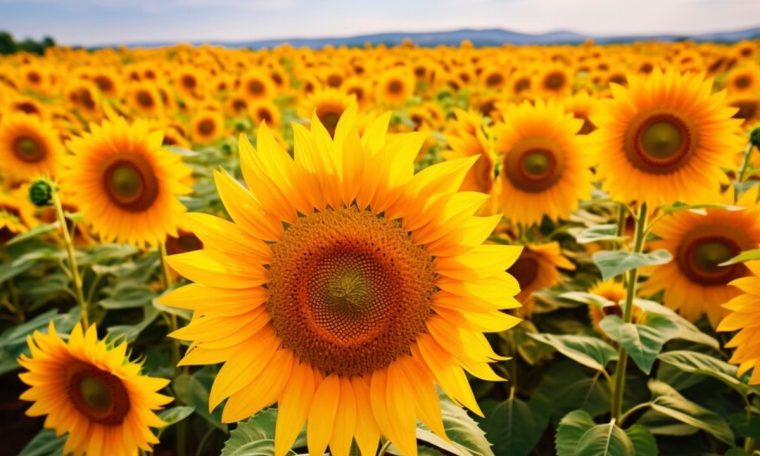
Introduction
Sunflowers, standing tall with their bright smiles and tall stems, have captivated people worldwide with their beauty and flexibility. But these flowers are more than just pretty faces. They have a big role in farming. They give us oil, food, and eco-friendly energy.
In this below-given article, we know about the overview of sunflower farming, cultivation practices, economic significance, and the numerous benefits it brings to both farmers and consumers.
The History of Sunflower Cultivation
More than 4,000 years ago, native people in North America started growing sunflowers. These special plants were not just for eating the seeds but also for spiritual and healing reasons. They used different parts of the plant for food, colors, and even making oil. Sunflowers didn’t reach Europe until the 16th century, and when they did, people there loved them for their pretty looks.
Sunflower Varieties and Characteristics
Sunflowers, scientifically known as Helianthus annuus, are like a team of unique characters with different looks. Some are tall and stand-alone, while others branch out with many flowers.
- There are even mini sunflowers that fit well in small spots or pots. Their cheerful faces come from the middle part, where there’s a bunch of florets, like a little crowd, and they’re all dressed up with bright yellow petals.
- Sunflowers are renowned for their fast growth, with some varieties reaching impressive heights of over 12 feet in a single growing season.
- Their large leaves efficiently capture sunlight, aiding in the photosynthesis process that fuels their rapid development.
Cultivation and Growing Conditions of Sunflower
- Site Selection: Sunflowers thrive in sunny locations with well-drained soil. They require around 6 to 8 hours of sunlight every day.
- Soil Preparation: Before planting, ensure the soil is all dug up nicely and weeds-free. Adding organic matter can enhance soil fertility and structure. In sunflower farming, thorough soil preparation is essential for optimal growth and yield, ensuring the soil is well-drained and enriched with necessary nutrients. The mahindra mini tractor can be a valuable asset in this process, offering reliable power and performance at a competitive price.
- Planting: Sunflowers are best sown right into the soil after the cold weather is gone. How deep you plant them depends on how big the seeds are, but a basic guide is to plant them around 1 to 2 inches deep.
- Spacing: Different kinds of sunflowers need space to stretch out. So, they should be put in the ground with about 1 to 3 feet between each one, giving them enough room to grow big.
- Watering and Feeding: When they’re starting out, sunflowers need enough water to grow well. But once they’re grown, they’re okay with less water.
Balanced fertilisation can promote healthier plants and larger blooms.
Lifecycle of Sunflowers
The sunflower’s lifecycle is a captivating growth, transformation, and harvest journey. From the emergence of the cotyledons to the unfurling of the iconic blossoms, each stage holds significance in the plant’s development. Once the flowers mature and their vibrant petals fall, the central disk transforms into a cluster of seeds encased in a protective shell.
Harvesting and Seed Processing
Harvesting sunflowers depends on the intended use. If growing for oil extraction, the heads are typically harvested when the back of the head turns yellow, and the seeds become plump. For confectionery sunflowers, harvesting occurs once the seeds are mature and the head has dried out. The seeds are then separated from the head and cleaned of debris.
Challenges in Sunflower Farming
While sunflowers are relatively hardy but susceptible to certain pests and diseases, common challenges include bird predation, fungal infections, and insect pests like aphids and caterpillars. Implementing integrated pest management strategies can help mitigate these challenges.
Conclusion
Sunflower farming presents avenues to produce wholesome cooking oil, foster pollinator habitats, and engage in sustainable agriculture. By grasping the cultivation methods, economic advantages, and environmental effects linked with sunflowers, farmers can set forth on a path that melds agricultural ingenuity with a constructive influence on their communities and the environment.
Whether it’s the delight of observing sunflower fields dancing in the wind or the contentment of a fruitful harvest, sunflower farming maintains its position as a symbol of agricultural promise. Considering factors like the swaraj 735 fe e on road price can further aid farmers in maximizing their farming potential.



